Aug 21, 2018
Boat Carpet Care
Boat carpet takes a terrific beating every year. Extreme moisture, sand, stones, harsh UV rays, etc. If you’re reading this post you have a
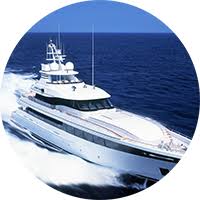
Big Boat
OR a
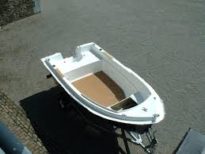
Small Boat
and you want to know how to keep the boat carpet clean. Keep on reading.
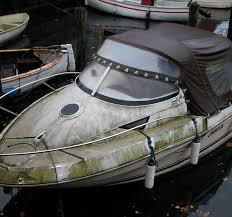
Is this your boat? Imagine what the carpet looks like.
Do’s and Don’ts for Boat Carpet Care
- Regularly vacuum and hose off your boat carpet to prevent staining.
- If there’s a spill, clean it up right away!
- Allow the carpet to dry thoroughly
Do NOT:
- Fold your carpet.
- Roll or store your carpet while wet. This will result in mold & mildew.
Boat Carpet Cleaning Tips
#1:
Start with the basics. Using plain vinegar and water is an ageless trick. Mix around 40 ounces of white vinegar to 1 gallon of water. Spray on the soiled area and let it soak until the area is saturated. Using a medium bristle brush, scrub the area gently. It’s important to thoroughly rinse the soiled spot and let it dry before using it again.
#2:
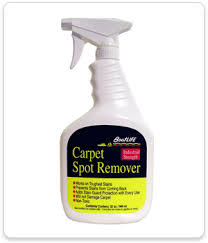
Boat Carpet cleaner
As an alternate use a commercial carpet product for cleaning your boat carpets. It’s best to use a non-foaming
product.
You can even use degreaser for those grease or oil stains as long as it does not have harsh solvents. Make sure to presoak and rinse the carpet thoroughly for the best results. Do not leave a residue as this traps dirt easier.
#3:
Fishermen (or women) will find fish blood to be a difficult stain to remove. However, it’s simple – use cold water and mild dish soap. Apply to the damaged area and let it soak in.
Do not use hot water because it will make the stain permanent. Blot with a towel or a clean sponge. Follow up with a soft-medium bristle brush and scrub after the first or second soaking. Again rinse the area thoroughly and repeat the process until clean.
One More Tip
#4:
Have a carpet that stinks? Baking soda works wonders for removing odors such as a wet dog or that fishy odor. A box of baking soda works great in a closet too.
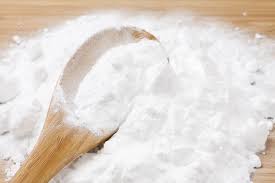
Use Baking soda for a Boat Carpet Cleaner
Baking soda will also assist in eliminating some stains. Lightly mist the carpet first, then sprinkle a generous amount of baking soda over it. The longer you let it sit, the more it will absorb. Allow 3 hours minimum – and it can be left overnight. Be patient, after it’s done its job – merely vacuum it up.
Hint: place a layer of “PRESS N SEAL” over the baking soda to keep the moisture in – it works better that way.
Follow these simple carpet cleaning tips, and your boat carpet will stay fresh and clean for years to come.
Don’t forget to clean it at the end of the boating season.
Where is PWS?
PWS is located in the center of Door County at 7325 St Hwy 57. It is located 1 mile North of County MM (Hwy 42) and South of Sturgeon Bay. Look for the intersection of Idlewild Road.
Want us to address a dock or boat lift topic for you? Feel free to give us a call.
Call Jerry at 920-493-4404 or Email Jerry@wisconsinpws.com for more information.
Jul 31, 2018
Boat safety
Boat safety should be part of Wisconsin’s three great seasons for boating. Yes, 3 seasons and then comes winter!
Boat SafetyTips

Boat Safety Rule #1- Everyone needs one
- Life Jackets are Mandatory: We all understand that life jackets can save lives. But so many of us don’t bother wearing them when we hit the water. Whether you don’t like the way they feel, or they don’t look cool, life jackets are there for a purpose. Make sure all kids wear their life jackets. A life jacket could easily save your child’s life. Besides – It’s the Law.
- Just like driving a car – Drinking and driving do NOT mix: Have a designated driver if you plan to drink. In Wisconsin boating violations, like drunk driving, count against your driver’s license and your insurance premiums.
- Check Your Lights: Are all of your boat’s lights working correctly? Don’t forget how quickly the sun sets. You don’t want to go back in the dark.
- Watch the Weather: Summer weather in Wisconsin can be unpredictable. Make sure you check the forecast and continue to keep tabs on the weather throughout the day. Don’t get caught in a sudden storm. It only takes about 15 minutes to go from clouds to a violent storm on the Bay.
Avoiding Boating Accidents
Here’s a hard fact: Boating accidents, like failure to yield right of way, to approaching a dock too fast, are all too common. Most of these accidents were avoidable.
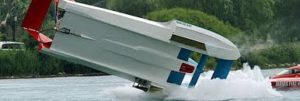
Maybe I should have turned wider
Additionally, 15% of all boating deaths had alcohol involved. Another 83% of drowning victims did not have a PFD.
It’s not a question IF boating accidents are a problem but instead, what can be done to reduce the rate of these accidents?
How You Can Prevent a Boating Accident
- Boating and Booze Do Not Mix: Do not drink and operate your vessel. If you take drinking and driving your car seriously, then the same caution should be exercised on the water.
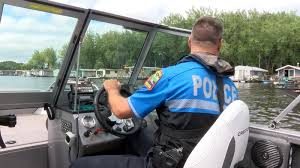
Boat Safety Rule #3- Don’t get a visit from him
Operating a boat while over the alcohol limit is illegal and puts everyone on the water at risk. You have slowed reaction times and a lack of judgment.
- Make PFDs mandatory: So often, an otherwise minimal accident can turn tragic if a passenger falls into the water without it. Remember, they do not have a seatbelt.
Though you may be a good swimmer, there are many ways that you could end up injured and unable to swim. That’s not to mention the possibility of rough waves, which could make swimming back to your boat impossible.
- Follow posted speed and wake limits and stay vigilant for risks.
Like car accidents, some things are out of your control. However, boating accidents are minimized if boaters simply:
- Stay sober behind the wheel,
- Wear PFDs,
- Follow speed and wake limits, and
- Brush up on the essential safety standards of operation.
Is a Boat Safety Course for you?
If you’re a new boater, boating safety courses are a no-brainer. Here are some take-homes you will learn:
- Boat Operation: There are some easily overlooked best practices that can help you avoid collisions, run aground or otherwise damage your boat.
- Emergency Procedures: From fires to dangerous weather, when you’re facing an emergency on the water, every second counts.
- Navigation: Even if you know your favorite boating spot like the back of your hand, there are too many variables to go without trip planning and preparation. These classes can teach you the safest ways to plan your next boating trip.
- Equipment: Even the safest boaters should know what equipment could save their lives in emergency situations. Ensure that all of your safety equipment is up to the task of keeping you and yours out of danger.
- Emergency Cut-Off Switch: If you go overboard, the last thing you want to see is your boat speeding away from you – especially if you aren’t wearing your PFD. Use a kill switch/emergency or cut-off switch fastened to your clothing. This ensures that the engine will shut off if you find yourself thrown into the water. It’s much like the shutoff switch on a treadmill at the gym.
- Keep Contact: Keep others informed about your boating plans. Let them know where you are going, especially if boating alone. Always keep a VHF radio on you, as well as your cell phone, safely stored in a waterproof container.
Boating safety classes will teach you the right procedure for most critical situations you may encounter while boating.
Practice boat safety and enjoy the ride.
Reminder
PWS is located in the center of Door County at 7325 St Hwy 57. It is located 1 mile North of County MM (Hwy 42) and South of Sturgeon Bay. Look for the intersection of Idlewild Road.
Want us to address a dock or boat lift topic for you? Feel free to give us a call.
Call Jerry at 920-493-4404 or Email Jerry@wisconsinpws.com for more information.
Jul 17, 2018
Nothing lasts forever – including boat lift cables
Boat Lift cable problems require a thorough explanation.
There are two types of normal cable wear:
- Internal cable abrasion- This occurs whenever strands work against each other under load.
- External abrasion – This will occur when the cable bends around the winch drum and rubs against the adjoining cable wrap. It also occurs when the cable rubs against the side of the winch drum
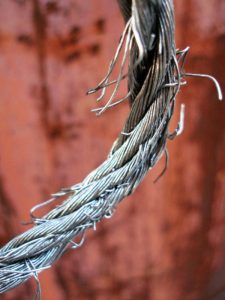
Frayed Boat Lift Cable
Types of Steel used as a Boat Lift Cable
Galvanized Steel: Galvanized steel is carbon steel made corrosion resistant by the application of a thin layer of zinc oxide. A “hot dip” in a molten zinc bath results in galvanizing the cable. The process applies a thin layer or coating of zinc to the steel to increase the metal’s resistance to corrosion.
Galvanized steel is less expensive than stainless steel due to the differences in the processing of each. Galvanized steel is stronger than stainless steel. The downside to galvanized steel is the fact that it has a higher electron-potential than stainless steel, making its’ corrosion resistance less effective because it does NOT regenerate when damaged.
Stainless Steel: Stainless steel is carbon steel which is mixed with about 10% chromium to resist oxidation or corrosion. The chromium forms a chromium oxide layer that promotes resistance to corrosion. When exposed to oxygen the protective coating WILL regenerate. The anti-corrosion of the chromium merely needs oxygen to maintain this property of resistance.
All Lift Cables Will Require some Maintenance
The winch and lift cables require periodic attention. Remember, these (2) items do all the “work” on your lift. They do the lifting of the rack assembly with the weight of the entire boat and motor on it.
Boat lift cables are manufactured out of either stainless or galvanized steel.
Galvanized cable is used as the winch cable on heavy boats. Stainless steel cables are used for the remaining cables on top brands like ShoreMaster.
Both types of steel offer the benefit of corrosion resistance and strength. However, watch for the noteworthy differences mentioned above that require your attention.
Corrosion
Galvanized cables that break usually show signs of corrosion or rust in advance. Typically, the failure is located near the winch when the rack is in a lowered position. Another common site for corrosion is at the bottom of the cable where it secures to the frame on some brands.
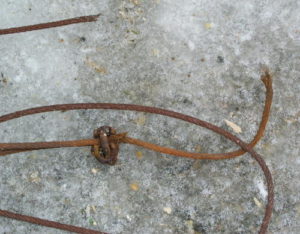
Rusted Boat Lift Cable
A slight discoloration indicates that the protective galvanizing coating may have worn away. Heavy concentrations of rust indicate that the steel cable is losing strength and requires replacement immediately.
How long should a cable last?
Experts claim galvanized cables require replacement every two years. All things being equal, a stainless cable will last up to twice as long.
A point often overlooked – internal abrasion or rust is hidden and may not show external damage on the cable during a visual inspection. A boat lift cable like this may sometimes fail without prior warning.
Other causes of cable failure
An improperly positioned boat puts extra strain on any boat lift cable. Wave action pounding against the boat hull or jamming the rack against the frame may send your boat into the water with a corroded or damaged cable. Even a new cable may “snap” if you jam the rack against the frame.
When in doubt, replace the cable; trying to squeeze another year out of a $95 cable that you know s damaged or rusting isn’t worth the risk.
In Conclusion… What Can You Do For Your Boat Lift Cable?
- In spring and fall put a short blast or two of PENETRATING OIL on the cables. Spray the cables wrapped around the winch drum from the top of the winch. Do not soak the cable; you’ll only contaminate the water. Use only penetrating oil. A quick spray during the summer is very helpful.
- NEVER USE GREASE to lubricate the cables. (grease traps the moisture inside the cable accelerating its deterioration).
- Inspect cables for frays and rust – Caution – wear leather gloves to prevent injury to your hands. Check near the top of the winch cable as this is the most common area for frays. Replace as needed.
- Check all cables to assure correct alignment on the rack pulleys.
- With your boat correctly positioned on the lift, check for any slack in the cables. All cables should be equal in tension. Contact PWS for adjustment, if needed.
- Look for cable corrosion near the winch with the rack all the way down. Maintain weight on the rack to assure proper tension on the cables.
We hope that this article will make your life easier and lend more confidence to your selections. Your boat lift is an investment, and as such we want to help you make wise decisions.
Reminder
PWS is located in the center of Door County at 7325 St Hwy 57. It is located 1 mile North of County MM (Hwy 42) and South of Sturgeon Bay. Look for the intersection of Idlewild Road.
Want us to address a dock or boat lift topic for you? Feel free to give us a call.
Call Jerry at 920-493-4404 or Email Jerry@wisconsinpws.com for more information.
Jul 10, 2018
When does a Lift Cable need Replacement?
Lift Cable replacement depends on a variety of conditions:
- Was the lift adequately sized for the boat?
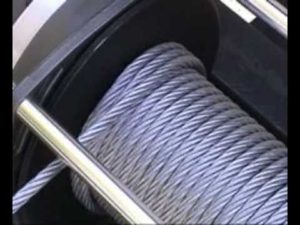
Properly wound Boat lift cable
- Did you change boats since you originally bought the lift?
- Is there visual damage to the cable?
- How well is the lift cable maintained?
- How often has it been lubricated?
- What lubricant is used?
- Is the cable winding correctly on the winch drum?
- Are the cables frayed?
- Is there corrosion on the cable?
When & How Do I Inspect a Lift Cable?
The best time to inspect the cables is when it is on dry land. That way you can check all of the critical points. Ideally, the lifting rack is in the lowered position, so more cable is exposed at the winch. Try not to let the cables go slack by lowering the rack too far.
If you inspect the lift while it’s in the water, raise the lift rack out of the water to do the inspection. A complete inspection at the bottom of the lift cable should be done when the lift is on the shore again.
In both cases, examine all exposed cables for frayed or rusted wires. Pay particular attention to the cable coming from the winch.
What does a frayed boat lift cable look like?

Frayed Boat Lift Cable
Look for frayed or rusted areas on the cable. The greater the number of frayed wires the greater the risk of failure.
Excessive rust on the cable means there could be major rust inside. Rust indicates a major weakening of the cable
and should be monitored carefully.
CAUTION – Always wear leather gloves when sliding your hands on these cables. The leather will protect your hands from a frayed wire which can be a painful experience for unprotected hands. Cloth gloves will not protect you.
The Next Thing to Inspect
What type of pulley material is used on the lift rack? To cut costs, some manufacturers still use a hard, black plastic pulley. These require extra attention. DO NOT lubricate any of these pulleys. Doing so will only contaminate the water.
If you have the black plastic pulleys (or any plastic pulley for that matter) follow these instructions:
With the rack above the water look inside the exposed ends of the rack tubes:
- Are the sides of the pulleys broken or bent over? (Common with plastic pullies)
- Are the cables still riding on the pulleys?
To completely check the pulleys, you should have someone raise the rack so you can see the entire pulley as it turns. The pulley sides could be damaged, and you can only see a portion of it from the ends of the tubes. Do this at all four corners.
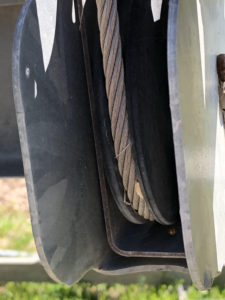
A plastic pulley on a boat lift Cable
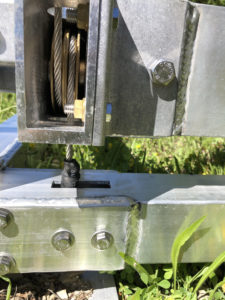
Brass pullies on a Boat Lift Cable
DO NOT place your fingers inside the tube to inspect it when it is moving. You may lose your finger.
Why are Plastic Pulleys inferior?
A lift cable will easily slip off a cracked or broken plastic pulley. With the lift cable off the pulley, the load on the cable is more than double the usual tension. It also results in broken internal wire strands due to the reduced diameter of the new bearing surface.
In this situation, the pulley needs to be replaced immediately. The heavier the boat, the more important this is.
FYI in the case of the brass pulleys used on a ShoreMaster lift, we have never seen a broken or chipped pulley. Note: Only the original vertical jet ski lifts from ShoreMaster had plastic pulleys. ShoreMaster corrected this problem almost immediately and only use brass pulleys on all their lifts today.
One Final Thing to Look For
If you have a sandy beach, look for sand inside the tubes. If sand is built up inside the rack tubes, remove it as soon as possible by flushing the tube out. A sand packed tube can happen after a storm when:
- The water was heavily agitated on a sandy beach; and
- While the rack is in a lowered position.
Sand can pack so tight in the tube that the cable can not move through it. The same is true of seaweed that gets into the tubes.
In Part 2 of this 2 part series, we discuss the types of cables used on lifts today. We will also address the life expectancy of cables.
SEE also – When Should a Lift Cable Be Replaced? PART 2 of 2 – UPDATED
Reminder
PWS is located in the center of Door County at 7325 St Hwy 57. It is located 1 mile North of County MM (Hwy 42) and South of Sturgeon Bay. Look for the intersection of Idlewild Road.
Want us to address a dock or boat lift topic for you? Feel free to give us a call.
Call Jerry at 920-493-4404 or Email Jerry@wisconsinpws.com for more information.
Jun 5, 2018
How to Select BoatLifts – Part 2
Boatlifts come in several configurations. In part 1 of this 2 part series, we discussed vertical and cantilever lifts. What about boatlifts for larger boats?
Next, we’ll discuss Elevator and Hydraulic boatlifts.
Elevator Lift
The elevator boatlift can only be mounted on permanent piers. These piers usually consist of a concrete pier (or concrete capped, boulder pier) or as an alternate a pier mounted on permanent pilings. As shown below, the elevator lift raises the boat parallel to the pier for easy access to the boat. They are commonly used in channels and lakes with significant fluctuations in water depth.
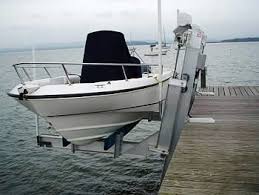
Elevator BoatLifts
The elevator lift is powered by one or two synchronized A.C. electric motors depending on the unit size. There is no need to hand-crank this lift. A wireless remote control is used to raise or lower the boat.
Elevator boatlifts are capable of stopping anywhere along its vertical travel so it makes it simple to load and unload a boat. This boatlift makes the boat readily accessible for covering with a boat cover and loading.
Hydraulic BoatLift
In general, Hydraulic boatlifts will travel 4’, 5′ or 6’ vertically depending on the model ordered. They will handle loads up to 32,000 lbs.
Because the base is wider than a typical cantilever or vertical boat lift, you have more stability in storms.
The Hydraulic lift is one of the best for high waves and water surges. The D.C. operated units are quiet and use solar-powered batteries and wireless remote controls. No A.C. power required.
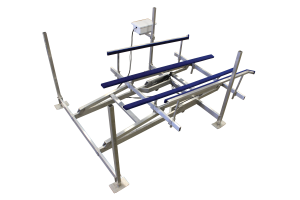
Hydraulic BoatLifts by ShoreMaster
Where can you find the solution to any boatlift situation?
At Pier & Waterfront Solutions, of course!
PWS is located 1 mile North of County MM (Hwy 42) at 7325 St. Hwy 42/57. That’s just 3 miles South of Sturgeon Bay. Look for the Idlewild Road intersection.
Our staff is ready to assist year round.
Call if you want to see an issue discussed on our site.
Contact Jerry at 920-493-4404 or Email Jerry@wisconsinpws.com with your questions.




















